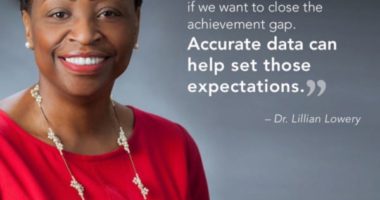Kati Haycock, director of The Education Trust, on the President’s Economic Summit
I’m an educator, not an economist. But whether you are focused on the health of our economy or the health of our democracy, it is very clear that America’s young people need to learn more in school.
We are seeing real and important achievement improvements in elementary schools. We’re even making some progress in middle schools. But we’re losing ground in our high schools – at least in part because our energy and our resources have been focused on the early grades. Why? Because we’ve been operating on the idea that education is like inoculation – that if we get it right for kids in those early years, we can prevent later school failure.
But experience is teaching us that that’s not true. Education instead turns out to be more like nutrition. You have to start early with that quality diet – and then continue all the way up the line. For poor kids, in particular, that means high quality pre-k education, elementary and secondary schools with rigorous standards, and colleges that feel some responsibility not just to admit them, but to make sure they succeed.
High schools, though, are the cornerstone. They can improve, no question about it. But they won’t until we get more honest about the obstacles to improvement.
First, we need to be honest about the problem:
- Reading, for example, is a hugely important skill in the information economy. Yet approximately one-quarter of our 12th graders read below even the basic level. And todays 12th graders actually have somewhat weaker reading skills than their counterparts two decades ago.
- Math performance, on the other hand, is up slightly but all of this improvement is attributable to stronger math skills that youngsters are bringing up from elementary school. Young Americans actually grow less in high school today than in the past.
- Underneath these averages the story lines are even more frightening. By the end of high school, Latino and African American youngsterswho together comprise about one-third of our studentsare performing about the same as white 8th graders. And after narrowing for more than 20 years, the gap at the end of high school grew wider through the nineties.
- And we need to be honest about the fact that while low-income and minority students are most egregiously shortchanged by our high schools, high schools aren’t even serving our most fortunate students all that well. On international tests of high school aged students, our top students dont fare very well. Among 15 year olds, we have fewer than half as many students in the top achievement categories and at least 50% more in the bottom achieving categories than high performing countries. In math, our high SES kids rank 23rd compared to high income kids in the other OECD countriesalmost exactly where our low SES kids rank compared to theirs. On both PISA and TIMSS, the closest country to us is Latvia.
So what do we do? Again its about getting honest, and confronting some difficult truths.
- We must get honest, first, about how many of our students aren’t even reaching these modest levels of achievement … because theyre dropping out of school. Among entering white and Asian 9th graders, a full one quarter are not emerging with a diploma 4 years later; for blacks and Latinos, the rates are closer to half. But rather than forcing honest reporting of these data at the local and state level … we’ve mostly taken a pass over these last few years.
- We need to get honest, second, with students themselves about what they need to know and be able to do to have any chance of getting a foothold in this economy. As we know from the American Diploma Project, standards for high school seniors generally don’t reflect the knowledge and skills needed for college and work. Consequently, a lot of kids follow all the rules, do everything they are asked to do, then are shocked to find themselves totally unprepared to pursue their dreams. Sure, give states money to build better assessments. But first, they need to gather k-12, higher education and business leaders to ensure that the high school standards have meaning in the real world. Otherwise, new assessments will simply reinforce the problem.
- Third, we need to honestly acknowledge that teachers are right when they tell us that there are a set of kids who are entering high school so far behind that they won’t reach standards without special interventions. Those kids and their teachers dont just need better teststhey need real, concrete help and the resources to put new supports in place.
- Finally, and perhaps most important, we need to get honest about teachers themselves. We raised expectations for kids without commensurate increases in standards for teachers, leaving many of them unprepared for the challenges of standards-based education. Even more damaging, we assign our least prepared teachers to the very kids who most need our best. Instead of mounting an all-out effort to tackle these twin problems through the highly qualified teacher provisions in NCLB, though, we’ve allowed states to pretend the problem doesn’t exist. Missed opportunity, with terrible consequences.
For a very long time, this country has tolerated pretty mediocre results from high school students and from high schools themselves. Worse, we have tolerated – even come to accept as inevitable – a large achievement gap separating poor and minority students from other young Americans.
You’ve been told over and over again that these kids just cant learnwhen the truth is that its we adults who are the problem. Every day some teachers and some schools show through their own results that we can indeed teach these students to very high levels.
This President has made a huge contribution by putting higher academic achievement and gap-closing squarely at the top of the federal education agenda and a lot of usincluding, frankly, this Democratwill be forever grateful to him for that. It was an enormous step, but its not enough. The question for all of us today is how to bring every bit of the leverage of No Child Left Behind to bear on changing results for poor and minority kids and how to align other federal policiesfrom Head Start through the Perkins Vocational Ed to the Higher Education Actto dramatically ratchet-up achievement at every level and close the achievement gap once and for all.



